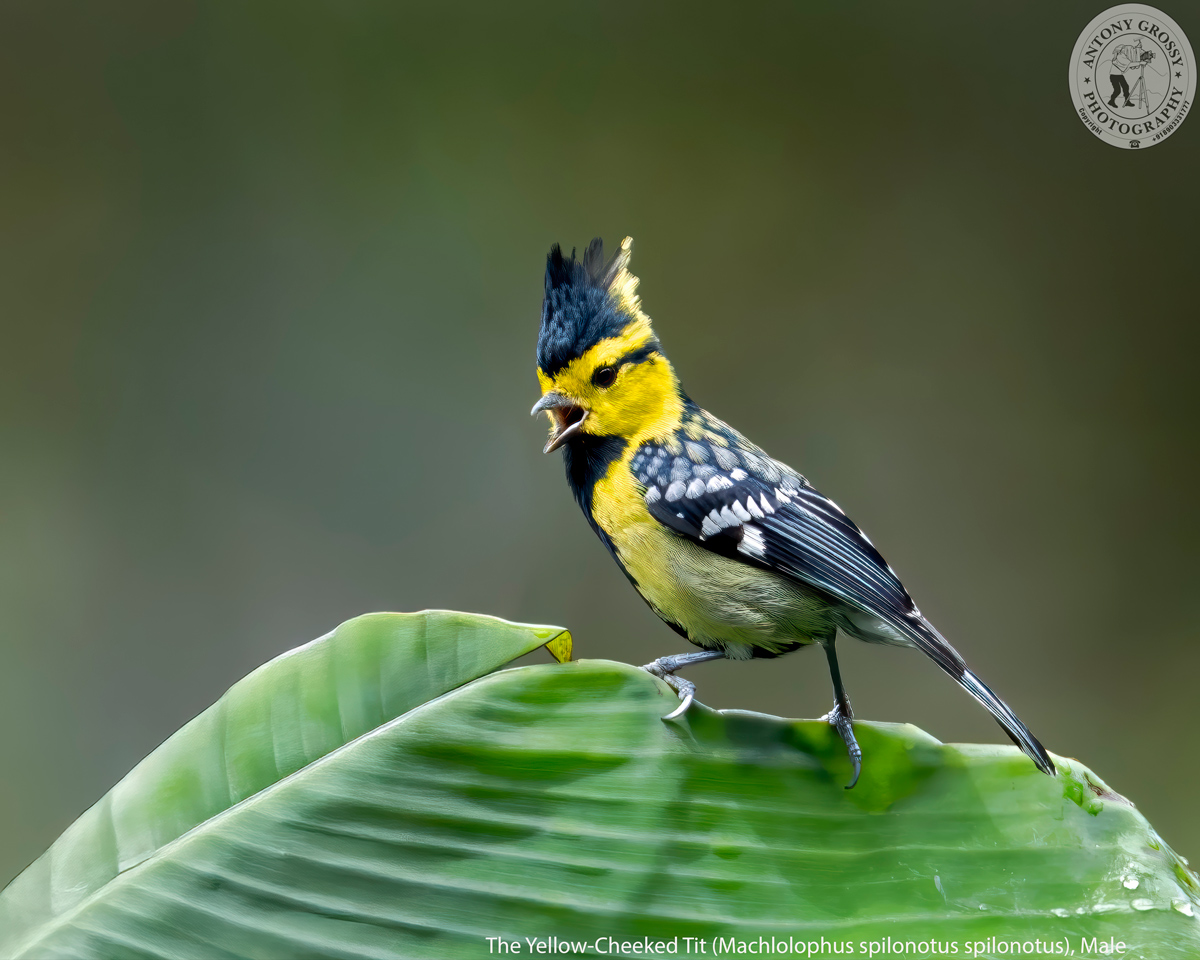

|
 |
| A Dashing Dapper Elvis Looking Bird – The Yellow-Cheeked Tit, Male |
| The Yellow-Cheeked Tit is a dashing medium-sized tit can be found in broadleaf and mixed hill forests, as well as adjacent parks and gardens. Utterly unmistakable, with a bright yellow face and nape, which contrast smartly with a black crest, throat, and breast. Wings are grey and black with white spots and bars. Gregarious; often in small flocks of its own species or with large mixed feeding flocks. Differs from Himalayan Black-Lored Tit mainly in yellow forehead and lores, green mantle streaked blackish, and whitish wingbars. . . . . . . . …. ………….. ……………….. .. …. …. ……….. … …. ……….. … …. ………… ………….. ………… ………… ….. ………. …………. …….. ……………. …… …. …. ……….. … …. ……….. .. ………… ….. ………. …………. …….. ……………. … The Yellow-Cheeked Tit is a medium-sized to large size tit with erect black crest and eyestripe and yellow cheeks. It measures between 12.55 to 15.5 cm in length and weighs about 18 to 23 gms. The Male of nominate race has forehead and lores to supercilium and nuchal spot yellow, crown and crest to side of nape black, yellow nape extending upwards onto tips of longest crest feathers; broad black eyestripe from eye to rear ear-coverts; upperparts olive-green (greener in NE Myanmar), tinged yellow, with blackish centres of mantle, back and scapular feathers, rump slightly greyish; tail black, fringed bluish-grey, all feathers narrowly tipped white, outer web of outermost feather white; upperwing-coverts black, median and greater coverts broadly tipped white, alula finely tipped white; flight-feathers blackish-grey, tertials narrowly fringed pale grey and broadly tipped white, secondaries and primaries fringed bluish-grey, outer primaries broadly white at base (forming short panel on closed wing); cheeks, ear-coverts and side of neck yellow; chin, throat (including side of throat) to centre of breast and continuing in irregular line to centre of belly black, slightly glossed blue on throat and breast; sides of breast and belly pale olive, tinged yellowish, flanks the same or greyish-olive, undertail-coverts dark grey, tipped whitish; underwing-coverts blackish, broadly tipped white; in worn plumage, upperparts duller or greyer and dark centres of mantle and scapulars larger, fringes of flight-feathers reduced, white tips of tail abraded, ventral line slightly broader, rest of underparts paler; iris brown; bill dark greyish-horn or black; legs slate-blue to grey. Female differs from male in having wingbars yellowish-white, fringes of flight-feathers olive and bib slightly duller. Juvenile is as adult, but crown duller, crest shorter, face and nuchal patch paler, upperparts duller, becoming greyer on rump and uppertail-coverts, whitish tail tips poorly defined (or absent), upperwing-coverts as adult but duller and tipped yellowish, secondaries fringed grey and tertials fringed olive-grey, cheeks and ear-coverts pale yellow, small dull brownish-black (paler on juvenile female) bib to centre of breast and ventral line to centre of belly, rest of underparts pale yellow, greyish wash on flanks. There are Four subspecies currently recognized with variation fairly well defined differing mainly in various aspects of plumage colour of upperparts, underparts, crown and upper nape, ear-coverts and chest. . . . . . . . …. ………….. ……………….. .. …. …. ……….. … …. ……….. … …. ………… ………….. ………… ………… ….. ………. …………. …….. ……………. …… …. …. ……….. … …. ……….. .. ………… ….. ………. …………. …….. ……………. … The Yellow-Cheeked Tit is distributed from Eastern Nepal along the Himalayas to Central and Southern China, Myanmar, Thailand and Indochina. It is found in deciduous or mixed forest at heights between 1200 to 3100 mtrs, as well as more open areas including gardens. Favours open temperate and subtropical deciduous or mixed forests with Oak, Pine and Rhododendron, also secondary forest, bamboo, edges of (usually well-wooded) cultivation, including plantations and areas with scattered trees; in South East Asia also favours evergreen hill forests and large gardens. Resident; also short-distance altitudinal migrant, descending to lower levels upto 500 mtrs in non-breeding season. . . . . . . . …. ………….. ……………….. .. …. …. ……….. … …. ……….. … …. ………… ………….. ………… ………… ….. ………. …………. …….. ……………. …… …. …. ……….. … …. ……….. .. ………… ….. ………. …………. …….. ……………. … Diet includes small invertebrates and larvae, including spiders, also buds and some fruit, e.g. berries. Forages usually in pairs or small family parties; in non-breeding season in mixed-species foraging flocks with other Tits and small Babblers. Fairly tame and often confiding, and noisy. Actively forages in middle and lower levels of forest trees, also in shrubs and undergrowth. . . . . . . . …. ………….. ……………….. .. …. …. ……….. … …. ……….. … …. ………… ………….. ………… ………… ….. ………. …………. …….. ……………. …… …. …. ……….. … …. ……….. .. ………… ….. ………. …………. …….. ……………. … Calls include si-si-si or more drawn-out si-si-pudi-pudi, or tsee-tsee-tsee, si-si or ki-ki beer, ki-ki beer, ki-ki beer, ki-ki beer, and a witch-a witch-a witch-a, often in combination with prolonged churrr-r-r-r-r-r, also a harsh krrank-it, krrank-it, krrank; calls generally similar in tone and quality to those of P. major. Song is a rapid repetition of 3-note, ringing phrase, chiu-chiu-piu, cha, chiu-chiu-piu, cha, chiu-chiu-piu, cha or dzi-dzi-pu, dzi-dzi-pu. . . . . . . . . . . . . . . . . . . . . . . . . . . . . . . . . . . . . . . . . . . . . . . …………………….. ………………………………………………………………… ………………………………………………………………………………………………………………………………………………………………………………………….. ………………………………. .. ……… …… … …. ……….. Description Credit Birds of the World (The Cornell Lab), Oiseaux, Animalia, Birds of India | Bird World, Bird Count India & Wiki. |
  |
|
|






































































































































































































































































































































































































































































































































































































































































